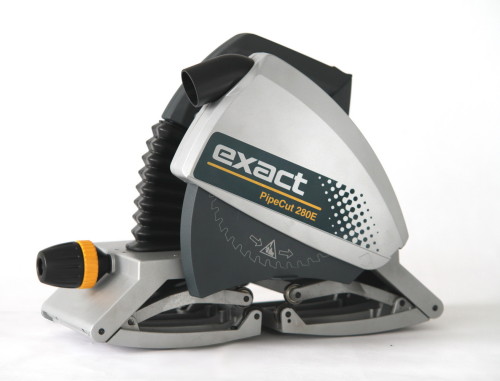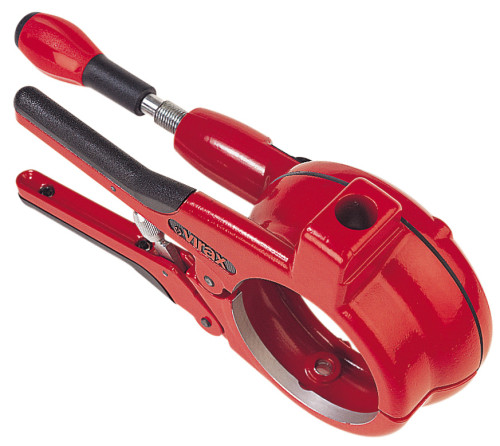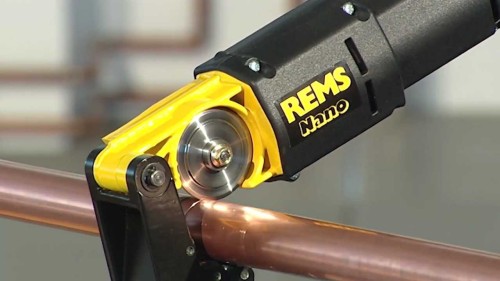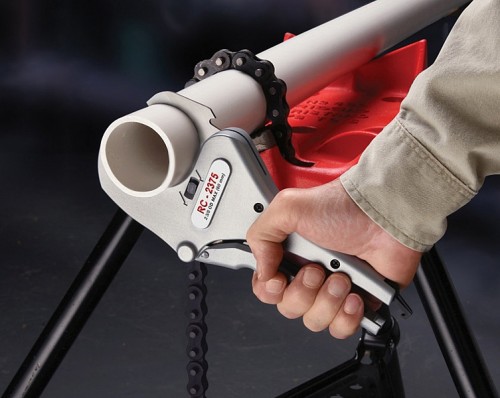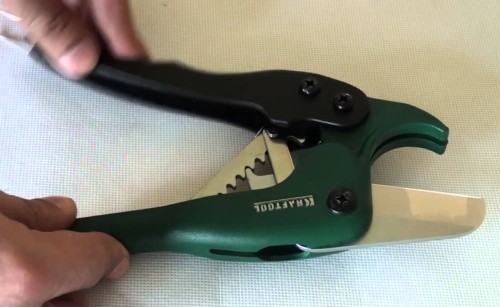
Truborez - how to choose and use Instruments

Installation and replacement of pipes during plumbing work is not required without cutting individual elements to fragments of the desired size. The best way to split the pipe on the part is the use of a special tool - pipe cut. Using this device, you will be able to qualitatively and smoothly cut the pipe, obtaining smooth, smooth and neat edges in the dissection places. Unlike simple hacksaws, pipe cutting works well and quickly, saving your strength and time. How to choose a suitable tool and how to use it, you will learn from this article.
How to choose Truborez
Experienced plumbers know that the pipeline is not a universal device. Depending on the type and thickness of the pipes, you should use different tools. There are such pipe cutters that help to work with several types of materials, but certain models are suitable exclusively for some particular type of pipes. For domestic use, there is enough tool for cutting steel pipes. With the help of such an appliance you can work with both light plastic and copper structures and pipes from more durable materials. And if you buy pipe cutter for plastic pipesThe use of it for cutting steel pipes will be impossible.
To decide which tool you need, you need to get acquainted with different types of pipe cuts. We will talk about their classifications further.
Classification of instruments on the thickness of the processed pipes
The desired tool should be chosen based on how the pipes you have to work. In this question, it is important to take into account not only the material of manufacturing structures, but also the thickness of their walls. So, depending on the thickness of the pipes, one of the following types of pipe cutters can be chosen:
- Tool for working with thin-walled structures. This category includes pipe cutters for copper pipes, metalplastic, brass, thin stainless steel. As a rule, in this case, the models of roller or incisive type are used.
- Trubores for processing thick-walled pipes made of cast iron or steel. Such devices include chain, multiple and detachable pipe cutters.
- The third category is a tool suitable for working with fragile structures, for example, with concrete or ceramics pipes. In such cases, it is customary to use chain type pipe cutters.
Classification of pipe cuts depending on the type of construction
There are several different types of tools that differ from each other features of their design. Consider them in more detail:
- The cutting pipeline, often used for cutting plastic pipes, is a kind of clip made of steel. It records special durable discs that provide cutting material. These discs are also made of steel, their position can be adjusted at its discretion. The maximum diameter of the pipe with which this tool can work is 10 cm. In the process of separating the pipe, the cut on the end is accurate and smooth.
- Manual roller pipes are designed for steel pipes. A similar tool consists of 1-3 rollers responsible for cutting pipes, as well as from guide rollers. From the number of rollers directly depends the diameter of pipes that can be processed using this device. For example, three-roller tubery can cut a diameter structure to 10 cm, while a tool with one roller cope with the pipe is not wider than 5 cm in diameter. In contrast to the previous type, these pipe cutters work not so carefully, the slice is not very smooth and may contain burrs.
- Tools with chain type design help working with fragile materials: ceramics, concrete, cast iron. In these pipes, there is a tensioning mechanism, swivel levers, as well as chains equipped with cutting rollers. The principle of such a device is quite simple: the chain is dragged around the pipe and crashes into it by turning the levers.
- Rotary or rotary telescopic tool is the most expensive device that allows you to carry out work in the most difficult and unfavorable conditions, for example, on the bottom of the kittlers and trenches, as well as under water. The design features of such a pipe exhibit the same interchangeable rollers, which are fixed around the pipe, cutting it. The tool also has a removable handle with which it is driven. The same handle allows you to press the cutting rollers in the process of work. Rotary pipe cutting perfectly copes with the most durable structures, the wall thickness of which reaches 19 mm.
- For cutting metal-plastic pipes, it is convenient to use tools with a snoring mechanism. These are small to the size of fixtures that cut thin single-layer pipes. The peculiarity of the ratchet mechanism is that after cutting material, the blade is returned to its original position. However, it will not work for pipe cutter for pipes with a diameter of more than 3 cm.
Types of pipe cutters on the principle of action
Trubores are also customary to classify by type of action. Consider various types of tools:
- Manual pipe cutters are usually used for household purposes. The principle of action of such a tool is based on the muscular work of a person. This is the easiest and cheapest view of the pipe cutters, besides, even those who do not have specific skills in working with plumbing can apply them.
- Electric pipe cutting is equipped with an engine with which the tool is driven. Such devices are more expensive than manual analogs, but it is easier to work with them and faster. First, the master does not need to apply excess physical strength, and secondly, the process of cutting pipes is much faster. Electric pipe cutters are different: small compact models can be used for household work, and massive aggregates are used in production.
- Hydraulic pipe cutters. The principle of their work is based on fluid pressure. A similar device is equipped with a piston, a rod, as well as hydraulic pump. In the process of operation, the pump is putting pressure on the piston, and the pipe cutter comes into effect. When the water pressure is weakening, the cutters return to its original position. Such tools do not need to be connected to the power grid, however, the power of them is noticeably less than that of electric pipe cutters.
- Another type of tool is pneumatic pipe cutters. They are used to work with pipes, the diameter of which reaches 130 cm. These fixtures can be equipped with incisors of various types, therefore, pipe cutters are used for both plastic pipes and solid cast iron structures. Pneumatic models are not so compact as their electrical counterparts. Some tools possess large dimensions and can weigh about 60 kg. As a rule, special trolleys for transportation are sold with similar pipes.
How to choose a tool depending on the material of the processed pipes
Before purchasing Truboresis, you need to consider with what pipes you will have to work. Consider the classification of tools depending on the material being processed:
- Copper pipes have one distinctive feature: they are easily bent and deformed. To avoid damage to the pipe, you should select the correct tool for its cutting. The most appropriate variants include steel telescopic type or design with a ratchet mechanism. It is better if the blade of the tool will be made of alloy steel.
- Thin plastic pipes perfectly cut down with special scissors. Unlike the pipe cut, the scissors will cost their owner much cheaper, moreover, work with them does not cause any complications. However, if your front works are very large, then with a long use of scissors, the hands quickly get tired. Among other things, when buying such a tool, sometimes you can come across low-quality models. A good adaptation for working with plastic pipes is also considered to be rechargeable pipe cutter for polypropylene structures. However, with it, you can handle pipes with a size of no more than 4.2 cm in diameter. Telescopic devices, as well as models with a snoring mechanism, will also help in working with metal-plastic pipes.
- Concrete, cast-iron, ceramic structures are easiest to cut with chain type tools - so you will not damage the fragile material and do not leave the chips and cracks on it.
How to use tool
Consider the features of the operating of pipe cutters on the example of metal and plastic pipes. For processing metal structures, roller pipes are most often used. It is necessary to use it as follows:
- On the tube, mark the place where you plan to make a cut. Metal structures before processing must first wet using ordinary water.
- Secure the pipe in the tool clamp. To do this, open the clamping block, put the pipe into it, move the roller to the outlined section of the section and tightly fix the metal in pipe cutter.
- Rotate the clamping mechanism, gradually enhancing the stretch. So you will cut the pipe along the line you scheduled.
Metal-plastic and polypropylene structures are easiest to cut the guillotine tool. This is done in several stages:
- First draw the mark on the pipe, which you will cut.
- Divide the handles of the pipe cut to the sides and put the pipe into it.
- Compact handles so that the blade touched the planned line.
- Applying efforts, press on the handle and cut the pipe in the right place.
Large diameter designs can also be cut with a similar tool, but it will take a little more time. In the process of work, the cutting rollers will have to move in a circle, while they, crashed into plastic, will not finally separate the pipe on the part.





